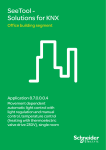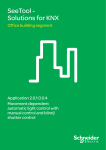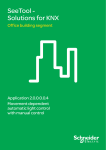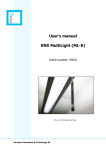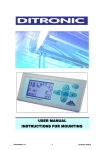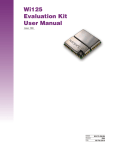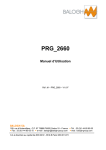Download SeeTool - Solutions for KNX
Transcript
SeeTool Solutions for KNX Office building segment Application 8.3.0.0.0.4 Movement dependent automatic light control with light regulation and manual control, temperature control (heating and cooling with KNX EMO valve drive), single room Application 8.3.0.0.0.4 Movement dependent automatic light control with light regulation and manual control, temperature control (heating and cooling with KNX EMO valve drive), single room Lighting and temperature control functions The lights are automatically switched ON or OFF dependant on people’s movement and existing brightness. When the lights are on, the light controller in the presence detector maintains the decided lux set point by dimming the lamp actuator dependant on the available daylight. In addition three predefined light levels and a permanent OFF can be activated manually by push-button. Temperature controller tries to keep room temperature at it’s setpoint by controlling KNX EMO valve drives for heating and cooling. The movement detection will automatically set the temperature control either into comfort or standby mode. A connected window contact will set the temperature control into frost/heat protection mode when the window is open. Lighting Application areas The application is defined to be used in office rooms and/or conference rooms where the level of light will be kept constant taking into account the amount of natural light. The solution offers sophisticated control of the lighting, heating and cooling with an automatic movement detector and additional manual control plus an open window sensing function to set temperature at comfort and standby mode. Energy savings Flexibility Combining the presence and daylight function with temperature control to the room application, we are able to utilize the daylight and temperature factors to optimize and save energy during the active period of use throughout the year. Presence dependant lighting control plus daylight harvesting can achieve a 65% electricity saving compared to installations without automatic function. At temperature side presence dependant control can lead to savings of up to 5% yearly in compare to rooms without automatic control functions. For optimized costs the device’s functional interaction is predefined. Functionality can be modified or changed at any time in the lifecycle and allows a maximum of flexibility and adaptation when walls are removed and rooms combined. Future proof The application is prepared and defined for integration into a Building Management System if required, through the open technology communication network. Reliability Design, planning and installation documents are pre-defined which makes the entire building process faster and more reliable. User documents and descriptions are prepared to assist in user training. The application works as an individual, stand alone room control unit or combined with the entire network. Temperature EN 15232 A class solution tested & validated Application 8.3.0.0.0.4 Movement dependent automatic light control with light regulation and manual control, temperature control (heating and cooling with KNX EMO valve drive), single room Technical specifications Functions Lighting control: The lights are automatically switched ON when a person enters the room and the brightness value is below the selected brightness threshold. If no movement is detected within a delay time of 25 minutes, the light will be dimmed down to minimum. If no movement is detected for another 5 minutes the light will be switched off. When the lights are on, the light controller in the presence detector maintains the decided lux set point by sending dimming telegrams to the lamp actuator. functions If the daylight will increase, the regulation dims down the artificial light. If it decreases, the regulation will dim up the artificial light. The lux set point after download and power failure is adjustable by ETS software. The default lux setpoint at the reference surface (e.g. desk) is 500 lux ±20% hysteresis. The user can also select the lux setpoint by the push-button unit. Button 1 will give high brightness (500 lux), button 2 will give medium brightness (300 lux) and button 3 low brightness (100 lux). With button 4 permanentOFF can be activated. The light will then be off until one of the other buttons is pressed. When permanent OFF is activated the status LED next to the button is blinking. Temperature control: Temperature controller tries to keep room temperature at it’s setpoint by controlling valves. Heating and Cooling is controlled by a KNX EMO valve drive each. Movement detection will automatically set the temperature control into comfort-mode. To save energy this will not happen until a person has been in the room for more than 3 minutes. In this way the temperature control is not affected if someone is present in the room just for a short period of time. If no movement is detected within a delay time of 25 minutes the temperature control is set into standby-mode. If a window contact (breaking contact) is connected to the EMO valve drive (heating) the temperature control will be set into frost/heat protection mode when the window is open. Comfort-mode: default room temperature setpoint heating 21 °C cooling 24 °C Standby-mode: default room temperature setpoint heating 19 °C cooling 26 °C Frost/Heat protection: heating 7 °C cooling 35 °C The setpoint can be adjusted by the user +/- 3°C from given setpoint. This is done by pushing „invisible“ buttons on both sides of the display frame. Application 8.3.0.0.0.4 Movement dependent automatic light control with light regulation and manual control, temperature control (heating and cooling with KNX EMO valve drive), single room Technical specifications Components Application consists of one presence detector, one temperature controller with buttons, one DIN-rail 0-10V control unit (mounted in the cabinet or close to the room) and KNX EMO valve drives. MTN647091 KNX Control Unit 0-10V REG-K/1-gang with manual mode MTN630919 KNX ARGUS Presence with light control and IR receiver MTN639118 KNX EMO valve drive with 2 binary inputs (here for heating purposes) MTN639118 KNX EMO valve drive with 2 binary inputs (here for cooling purposes) functions Design ranges (Frames not included. Other designs and colours available.) EXXACT WDE002939 KNX PB 2-gang with room temperature control unit Installation The presence detector is intended for ceiling mounting in a size 60 mounting box. It can also be mounted to ceilings using the surface mounting housing for ARGUS Presence (art.no. MTN550619). Application 8.3.0.0.0.4 Movement dependent automatic light control with light regulation and manual control, temperature control (heating and cooling with KNX EMO valve drive), single room Technical specifications Wiring diagram KNX Push-button 2-gang with room temperature control unit WDE002939 System component Lighting control Temperature control Manual control KNX Power supply L N KNX ARGUS Presence with light control and IR receiver MTN630919 Presence detection KNX Control unit 0-10 V REG-K/1-gang with manual mode MTN647091 Temperature control KNX KNX EMO valve drive MTN639118 (here for heating purposes) KNX EMO valve drive MTN639118 (here for cooling purposes) 0-10 V ballasts 0-10 V 0-10 V Window contacts (binary input 1) 0-10 V things work together Application 8.3.0.0.0.4 Movement dependent automatic light control with light regulation and manual control, temperature control (heating and cooling with KNX EMO valve drive), single room Technical specifications Note Number of controlled electronic interfaces highly depends on used ones, check with manufacturer recommendations. An electronic interface takes high inrush current. It is recommended that Type C MCB’s (Miniature Circuit Breaker’s) are used. Using Type B leads to decreased number of units. If window contact is not used, green and yellow wire has to be tied together (shortcircuit). settings Configuration The ETS tool is used to set the parameters for the devices in the application and to define the functional relationship between the devices by group addresses. The following parameters and group address relations must be set and assigned. The parameters should be set first and in the described order. The parameters which can be changed to fine tune the application are described further on. KNX Argus presence with light control KNX Push-button 2-gang with RTC 1 bit –> 2/1/3 0 Object A PB 1 2 byte –> 1/1/7 Closed-loop 1 bit –> 1/1/1 3 Object A PB 2 2 byte –> 1/1/7 61 Dimming output Closed-loop 4 bit –> 1/1/2 6 Object A PB 3 2 byte –> 1/1/7 62 Setpoint 1 –> 1/1/3 9 Value object A PB 4 1 byte –> 1/1/8 64 Fb. operat. modeClosed-loop 1 bit –> 1/1/9 70 Value input <– 1/1/8 11 Status feedb. object PB 4 12 Switch object 1 Block 2 60 Switch output Closed-loop 1 byte Closed-loop 1 byte 71 Lux value setting Closed-loop 2 byte <– 1/1/7 45 Frost/heat protection input Control 107 Result. act. value Send –> 1/1/6 (optional) 47 Comfort input 2 byte 109 Status feedback Safety pause 1 bit <– 1/1/4 110 Status feedback Brightness <– 1/1/5 1 byte General Actual value correction: enable Actual value (0-2000 Lux) installation site Lamp switched off: ________ Max. brightness of lamp: ________ Actual value (0-2000 Lux) reference surface Lamp switched off: ________ Max. brightness of lamp: ________ [Optional, to check regulation after download] Send actual value cyclically reference surface: enable Time base, send lux value: 1s Time factor, send lux value: 60 Block configuration Move/presence block 1: Move/presence block 2: Light control: disable enable enable 1 bit <– 1/1/9 1 bit <– 2/1/4 1 bit <– 2/1/3 62 Correcting variable heating (basic level) Control 1 byte –> 2/1/1 65 Correcting variable cooling (basic level) Control 1 byte –> 2/1/2 Push-button 1 Select push-button function: Control Edges with 2 byte values Push-button 1 – edges values Value 1 = basis * factor [= 500] Basis (possible values in brackets): 0,32 (0 to 655,04) Factor (0-2047): 1562 Push-button 2 Select push-button function: Edges with 2 byte values Block 2 general –> Movement sensors Sector-orientated settings: enable Dead time, beginning of movement: enable Time base: 1 min Time factor: 3 Push-button 2 – edges values Value 1 = basis * factor [= 300] Basis (possible values in brackets): 0,16 (0 to 327,52) Factor (0-2047): 1875 Block 2 general –> Brightness Movement detection is: brightness independ. Block 2 general –> Time Time base for staircase timer: Time factor for staircase timer: Push-button 3 Select push-button function: 1 min 25 Edges with 2 byte values Application 8.3.0.0.0.4 Movement dependent automatic light control with light regulation and manual control, temperature control (heating and cooling with KNX EMO valve drive), single room Technical specifications Configuration KNX Argus presence with light control KNX Push-button 2-gang with RTC General light control Automatic: Memory behaviour: Extended controller parameters: Push-button 3 – edges values Value 1 = basis * factor [= 100] Basis (possible values in brackets): 0,08 (0 to 163,76) Factor (0-2047): 1250 at object value 0 parameterised setpoint value enable General light control –> Control response in automatic mode –> Times Time base for staircase timer: 1 min Time factor for staircase timer: 25 General light control –> Control response in automatic mode –> Brightness Nominal value (10-2000 Lux) reference surface: 500 Hysteresis (10%-50%): 20 General light control –> Switching off in automatic mode Time base, dimming down time: Time factor, dimming down time: 1 min 5 KNX Control unit 0-10V REG-K/1-gang 1/1/1 –> 0 Switch object Channel 1 1 bit 1/1/2 –> 1 Dimming object Channel 1 4 bit 1/1/3 –> 2 Value object Channel 1 1 byte 1/1/4 <– 8 Status feedb. switch Channel 1 1 bit 1/1/5 <– 9 Status feedb. value Channel 1 1 byte NOTE: The read flag (R) must be set 1: General Status switch: active status resp. object Status value object: active status resp. object 1: Dimming time reduction Set 0: dimming time reduction for value telegram at: 6% Push-button 4 Select push-button function: Object A: Value: Trigger status LED: Switching 1 byte in steps 0-100% 0% Flashes when status feedback object equals 1 settings Control general Use control: Yes Controller type: Heating and cooling Duration of comfort extension: None Setpoint adjustment maintained after change in oper. mode: Yes Control general –> Actual temperature (resultant) Correct internal actual temperature factor [-128...127] * 0,1 K: 0 [NOTE: See description “fine tuning”] Control general –> Control heating Select heating system:Adjustment via control parameter Proportional range for heating in 0,1 K [10-255]: 40 Reset time for heating [1-255 min]: 20 Control general –> Control cooling Select cooling system:Adjustment via control parameter Proportional range for cooling in 0,1 K [10-255]: 40 Reset time for cooling [1-255 min]: 20 KNX EMO valve drive with 2 binary inputs (heating) 2/1/1 –> 0 Control value Input 1 byte 2/1/4 <– 7 Binary input 1 Switch 1 bit Input 1 Function: Command on rising edge: Command on falling edge: switch/ toggle off on KNX EMO valve drive with 2 binary inputs (cooling) 2/1/2 –> 0 Control value Input 1 byte Application 8.3.0.0.0.4 Movement dependent automatic light control with light regulation and manual control, temperature control (heating and cooling with KNX EMO valve drive), single room Technical specifications Group addresses Address Name (proposal) Function 1/1/1 Room 001 Light On/Off Light on/off by the light controller 1/1/2 Room 001 Light Dimming Light dimming up/down by the light controller 1/1/3 Room 001 Light Value Light absolute value by the light controller 1/1/4 Room 001 Light Status switch Feedback from actuator, On/Off 1/1/5 Room 001 Light Status value Feedback from actuator, 0-100% 1/1/6 Room 001 Light Resulting actual value Measured lux value by light controller (corrected value) 1/1/7 Room 001 Light Lux value setting Different lux values from push-button 1/1/8 Room 001 Light Permanent OFF (0%) Permanent OFF, movement detector disabled 1/1/9 Room 001 Light Feedb. operation mode Indication permanent off (0) and automatic regulation (1) 2/1/1 Room 001 Heating control value Heating 0-100%, sent by the room temperature controller to the EMO valve drive heating 2/1/2 Room 001 Cooling control value Cooling 0-100%, sent by the room temperature controller to the EMO valve drive cooling 2/1/3 Room 001 Comfort/Standby mode Change between comfort (1) and standby (0) mode 2/1/4 Room 001 Window contact Window open (1) –> frost/heat protection settings Application 8.3.0.0.0.4 Movement dependent automatic light control with light regulation and manual control, temperature control (heating and cooling with KNX EMO valve drive), single room Technical specifications Actual value correction The measured brightness value (actual value) can be corrected. A distinction is drawn here between the installation location of the presence detector and the reference area (a desk surface, for example). The brightness value of the reference area is determined with the aid of actual value correction and taking the brightness value measured by the presence detector at the installation location and an internal adjustment curve into account. In the case of light regulation it is not the brightness value at the installation location which is important but the brightness value at the reference area (desk). For actual value correction you will need a luxmeter (example: Roline TES-1335 or equivalent). Four measurements are required for actual value correction: • With the artificial lighting switched OFF, brightness is measured at the presence detector installation location. • With the artificial lighting switched OFF, brightness is measured at the reference area (desk, for example). • With the artificial lighting switched ON (maximum brightness), brightness is measured at the presence detector installation location. • With the artificial lighting switched ON (maximum brightness), brightness is measured at the reference area (desk, for example). settings The measurements can be done in daylight but not in clear sunshine, best condition is cloudy weather. To switch ON to maximum brightness a value telegram 100% can be sent from ETS to the value object of the control unit, for example. Note: the presence detector should not be in operation at this time. The four lux values measured must be entered as parameters in ETS. Parameter page Parameter Value General Actual value installation site, Lamp switched OFF 0…2000 lux General Actual value installation site, Max brightness of lamp (100%) 0…2000 lux General Actual value reference surface, Lamp switched OFF 0…2000 lux General Actual value reference surface, Max brightness of lamp (100%) 0…2000 lux Application 8.3.0.0.0.4 Movement dependent automatic light control with light regulation and manual control, temperature control (heating and cooling with KNX EMO valve drive), single room Technical specifications Fine tuning Some parameters can be changed to fine tune the solution to the building and specific requirements. Parameter which may need to be adjusted are listed below, our recommendation in brackets. KNX ARGUS presence detector with light control and IR receiver: The staircase timer (delay time) will be retriggered by every detected movement when the light is on. The light will be dimmed down to minimum if no movement has been detected within the specified time. If no movement is detected the light will stay on minimum level for a time period specified by the parameter „dimming down time“. After this time the light will be switched off. Parameter page Parameter Value General light control –> Control response in automatic mode –> Times Time base for staircase timer 1s/1 min/1h (1 min) General light control –> Control response in automatic mode –> Times Time factor for staircase timer 1-255 (25) General light control –> Switching off in automatic mode Time base, dimming down time 1 s/1 min/1 h (1 min) General light control –> Switching off in automatic mode Time factor, dimming down time 1-255 (5) fine tuning Delay time = Time base x Time factor Dimming down time = Time base x Time factor Lux level setpoint in reference area Parameter page Parameter Value General light control –>l Control response in auto. mode –> Brightness Nominal value reference surface 10-2000 lux (500 lux) General light control –>l Control response in auto. mode –> Brightness Hysteresis 10%-50% (20%) The actual brightness value (corrected measured value) can be sent cyclically to the bus via communication object 107. This can be used for test purpose together with ETS. If it is used for other purposes, the value should not be sent too often for bus load reasons. If there is no receiver to display the value in the project, the function should be disabled after the test phase. Parameter page Parameter Value General Send actual value cyclically, reference surface enable/disable (disable) General Time base, send lux value 1s/1 min/1 h (1 min) General Time factor, send lux value 1-255 (30) Cycle time = Time base x Time factor Application 8.3.0.0.0.4 Movement dependent automatic light control with light regulation and manual control, temperature control (heating and cooling with KNX EMO valve drive), single room Technical specifications Fine tuning The delay time for changing between standby-comfort is dependent on presence activity in a room. To save energy the switch-over from standby to comfort is done when movement is detected after a specified dead time. Then a staircase timer is started which will be retriggered by every detected movement. If no movement is detected the staircase timer will run out and standby mode is activated again. Parameter page Parameter Value Block 2 general –> Movement sensors Dead time, Time base 1s/1 min (1 min) Block 2 general –> Movement sensors Dead time, Time factor 1-255 (3) Block 2 general –> Times Time base for staircase timer 1s/1 min/1h (1 min) Block 2 general –> Times Time factor for staircase timer 1-255 (25) fine tuning KNX Push-button 2-gang with room temperature control unit: Push-buttons: The end user can select brightness level (lux value) with push-button 1, 2 and 3. These values can be changed with the parameters of the push-buttons. Parameter page Parameter Value Push-button 1 – edges values Value 1 = basis * factor (500 lux) Basis 0,01-327,68 (0,32) Push-button 1 – edges values Factor 0-2047 (1562) Push-button 2 – edges values Value 1 = basis * factor (300 lux) Basis 0,01-327,68 (0,16) Push-button 2 – edges values Factor 0-2047 (1875) Push-button 3 – edges values Value 1 = basis * factor (100 lux) Basis 0,01-327,68 (0,08) Push-button 3 – edges values Factor 0-2047 (1250) Note: Temperature controller parameter pages uses the unit Kelvin’s (K) for relative temperatures and Celsius (°C) degrees for absolute temperatures 1K = 1°C Room temperature controller: Default setpoints for heating and cooling (depends on presence in a room) Parameter page Parameter Value Control general –> Setpoints Heating, setpoint for comfort 5-40°C (21°C) Control general –> Setpoints Heating, setpoint for standby 5-40°C (19°C) Control general –> Setpoints Cooling, setpoint for comfort 5-40°C (24°C) Control general –> Setpoints Cooling, setpoint for standby 5-40°C (26°C) The user is allowed to adjust the default setpoint +/- within specified limits Parameter page Parameter Value Control general Max. upper setpoint adjustment 0-10 K (3 K) Control general Max. lower setpoint adjustment 0-10 K (3 K) 10 Application 8.3.0.0.0.4 Movement dependent automatic light control with light regulation and manual control, temperature control (heating and cooling with KNX EMO valve drive), single room Technical specifications Fine tuning Value correction of measured temperature: The temperature in the room is measured by the internal temperature sensor in the room temperature controller. The actual temperature is shown in the display. If the value is not representative for the room it is possible to adjust it by parameter. Actual temperature = measured temperature + adjustment value. Parameter page Parameter Value Control general –> Actual temperature (resultant) Correct internal actual temperature factor (-128...127) * 0,1 K 0 fine tuning Parameters for tuning heating control (Xp and Ti) Parameter page Parameter Value Control general –> Control heating Proportional range for heating in 0.1K 10-255 (40) Control general –> Control heating Reset time for heating in min 1-255 min (20) Parameters for tuning cooling control (Xp and Ti) Parameter page Parameter Value Control general –> Control cooling Proportional range for cooling in 0.1K 10-255 (40) Control general –> Control cooling Reset time for cooling in min 1-255 min (20) Power failure behaviour Behaviour when bus voltage fails: relay no (Light is OFF). Behaviour when bus voltage returns: switch off relay (Light is OFF). 11 Application 8.3.0.0.0.4 Movement dependent automatic light control with light regulation and manual control, temperature control (heating and cooling with KNX EMO valve drive), single room Technical specifications User manual The user manual provided for the application is an end users training material and can be installed at site when final submission is made. Please do no forget to cut out this quick guide for the user and attach to the wall next to the entrance to the room. Also, make sure the customer is aware of the installed applications function. Quick guide This room is equipped with a movement dependent automatic light control with light regulation and manual control, temperature control. Automatic mode operation Lighting control The lights are automatically switched ON when a person enters the room and the brightness value is below the selected brightness threshold. If no movement is detected within a delay time of 25 minutes, the light will be dimmed down to minimum. If no movement is detected for another 5 minutes the light will be switched off. When the lights are on, the light controller in the presence detector maintains the decided lux set point by sending dimming telegrams to the lamp actuator. If the daylight will increase, the regulation dims down the artificial light. If it decreases, the regulation will dim up the artificial light. 1 2 3 4 Manual mode operation The user can also select the lux set point by the pushbutton unit. Button 1 will give high brightness (500 lux), button 2 will give medium brightness (300 lux) and button 3 low brightness (100 lux). With button 4 permanent-OFF can be activated. The light will then be off until one of the other buttons is pressed. When permanent OFF is activated the status LED next to the button is blinking. 06-10 Application 8.3.0.0.0.4 service for your customer 12 Application 8.3.0.0.0.4 Movement dependent automatic light control with light regulation and manual control, temperature control (heating and cooling with KNX EMO valve drive), single room Technical specifications User manual Quick guide This room is equipped with a movement dependent automatic light control with light regulation and manual control, temperature control. Automatic mode operation Temperature control, heating/cooling Movement detection will automatically set the temperature control into comfortmode. To save energy this will not happen until a person has been in the room for more than 3 minutes. In this way the temperature control is not affected if someone is present in the room just for a short period of time. If no movement is detected within a delay time of 25 minutes the temperature control is set into standby-mode. „invisible“ buttons Comfort-mode: default room temperature set point heating 21 °C cooling 24 °C Standby-mode: default room temperature set point heating 19 °C cooling 26 °C Frost/Heat protection: heating 7 °C cooling 35 °C The set point can be adjusted by the user +/- 3°C from given set point. This is done by pushing „invisible“ buttons on both sides of the display frame. If a window contact (breaking contact) is connected to the EMO valve drive, the temperature control will be set into frost/heat protection mode when the window is open. 06-10 Application 8.3.0.0.0.4 ISC02083_EN service for your customer 13















